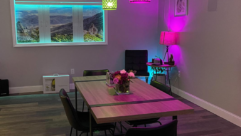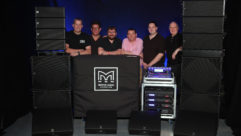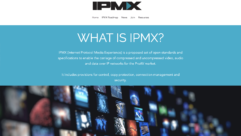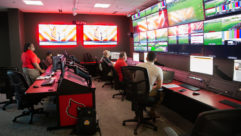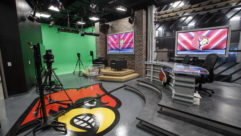
One-Stop Suppliers
Like most CEOs of AV systems integration firms, John Miceli is always scanning the horizon for new products that can help him design and deliver better client project solutions. But if you’re a product manufacturer trying to catch his eye with a new offering ? especially one that’s venturing beyond your established expertise ? don’t expect to get very far with him on your good name alone. ?Just because a manufacturer makes a great product or two doesn’t mean we’re going to love everything they do,? says Miceli, who runs Orlando, FL-based Technomedia Solutions. ?I commend companies that have tried to move beyond their niche, but product expansions have to be executed correctly, and products have to be well thought out ? not just conceived in a race to compete. Three-quarters of their vision can’t be on competitors and one-quarter on themselves.? Miceli’s mindset is one that a growing number of AV gear manufacturers might do well to contemplate. As more manufacturers ? from companies like Harman Pro to Loud T
The “Harmanization” model
Like most CEOs of AV systems integration firms, John Miceli is always scanning the horizon for new products that can help him design and deliver better client project solutions. But if you’re a product manufacturer trying to catch his eye with a new offering — especially one that’s venturing beyond your established expertise — don’t expect to get very far with him on your good name alone.
“Just because a manufacturer makes a great product or two doesn’t mean we’re going to love everything they do,” says Miceli, who runs Orlando, FL-based Technomedia Solutions. “I commend companies that have tried to move beyond their niche, but product expansions have to be executed correctly, and products have to be well thought out — not just conceived in a race to compete. Three-quarters of their vision can’t be on competitors and one-quarter on themselves.”
Miceli’s mindset is one that a growing number of AV gear manufacturers might do well to contemplate. As more manufacturers — from companies like Harman Pro to Loud Technologies to Barco — try to become more of a “one-stop” source for an ever wider range of AV gear, many are encountering some reticence on the part of those in the distribution channel.
Some manufacturers aggressively pursuing the “one-stop-shop” approach defend it by saying it brings more synergies to project designs and more potential buying efficiencies to contractors and integrators. But while some in the channel concur with that assessment, others, like Miceli, say they’re far more interested in the delivering the best solution, even if it still means buying gear the way they always have — piecemeal from specialists who have a long history of excellence in a particular product line — and assembling it into a total solution.
“We want to stick with products and manufacturers that are reliable,” he says. “If a company comes out with a product that’s not part of their core, we’re not likely to automatically embrace it. The real benefit comes when manufacturers develop products that are designed to work well together, not when they do it to grab more market share.”
At least one integrator, though, sees the value proposition of manufacturers broadening their lines. Bruce Banbury, president of Video Systems of the Carolinas, Charlotte, NC, says efforts by companies like Extron to move into video control systems and Crestron to move into switching gear can be beneficial.
“We think it’s great because it means more competition,” Banbury says. “It means the possibility of cheaper systems and the ability to have all gear from the same manufacturer talking together.”
The manufacturing sector’s “poster child” for the one-stop shop mentality may well be Harman Pro. Based in Northridge, CA, the Harman International division has managed to bring seven high-profile brands of diverse pro audio gear under its umbrella. Far from merely collecting disparate brand names, the company has been working to assemble a synergistic mix of products that can be brought to market as a total package. It’s an approach that makes sense in a market that puts a growing premium on networkable gear that can be readily purchased, installed, and operated, says Harman Pro President Mark Terry.
“Our model is unique in that we’ve crafted the concept of ‘centers of excellence,’” Terry says. “At each point in the audio signal chain we have one of the preeminent companies in the business. Each of our brands still functions as a standalone business, but we can come to market with a complete offering of products.”
Having built a stable of seven brands that offer a range of products that fall at multiple points along the price-performance spectrum — allowing users to select matched gear — Harman is now honing the next phase of a long-term total solutions strategy. That, Terry says, entails engineering gear from all of the companies to work more in sync, allowing for easier setup and configuration. Harman’s new HiQnet connectivity and control protocol is designed to further enhance the appeal of an all-Harman solution.
One-Stop Suppliers
Like most CEOs of AV systems integration firms, John Miceli is always scanning the horizon for new products that can help him design and deliver better client project solutions. But if you’re a product manufacturer trying to catch his eye with a new offering ? especially one that’s venturing beyond your established expertise ? don’t expect to get very far with him on your good name alone. ?Just because a manufacturer makes a great product or two doesn’t mean we’re going to love everything they do,? says Miceli, who runs Orlando, FL-based Technomedia Solutions. ?I commend companies that have tried to move beyond their niche, but product expansions have to be executed correctly, and products have to be well thought out ? not just conceived in a race to compete. Three-quarters of their vision can’t be on competitors and one-quarter on themselves.? Miceli’s mindset is one that a growing number of AV gear manufacturers might do well to contemplate. As more manufacturers ? from companies like Harman Pro to Loud T
“HiQnet will give users more control and flexibility when it comes to using Harman gear, but at the same time it doesn’t rule out the use of gear from other suppliers,” Terry says.
Looking ahead, Terry says Harman is focused on further expanding the range of products to include lower price-point gear and more application software. At the same time, there will be a more intense drive to sell more gear to integrators through the Harman network. “We’ll be looking to take more orders for complete Harman solutions,” he says.
While Harman’s multi-brand strategy is unique, it’s certainly not the only way to achieve “one-stop” supplier stature.
Take Extron Electronics, for example. The 20-year-old Anaheim, CA-based company has stepped up the pace of bringing more video control-related products to market under its own name. From video interfaces and switchers, Extron has moved into designing, manufacturing, and marketing distribution amplifiers, scalers, scan converters, signal processors, and, most recently, loudspeakers.
Extron’s vice president of marketing, Lee Dodson, says building up the line of presentation support gear — so-called “glue” products — addresses current market needs.
“By offering complete systems, we’re able to control the integrity of the design, lower the manufacturing cost, and pass along savings,” he says. “For customers, the one-stop shop trend can be a huge advantage: Components of the system may be combined and tailored for a lower-cost approach. And systems don’t need to be redesigned as often to chase separate manufacturer model changes.”
But others in the channel say the trend toward the “one-stop” model may have some serious consequences for distributors, end-users, and even manufacturers.
Mike Oltz, president of John B. Anthony Co./Metro Reps, a Fairfield, NJ-based independent pro audio rep firm, says he fears efforts by companies like Harman Pro to capture more of the market for a broader range of gear may not only upset long-established channel relationships, but also possibly alienate customers. He worries about what a proliferation of manufacturer strategies similar to Harman Pro’s will mean for manufacturer representatives, dealers, integrators, and end-users. The result, he says, could be fewer choices for customers — a risky move in a world where customers want more, not fewer options.
“I question whether all of this consolidation on the part of manufacturers is beneficial,” he says. “I think a lot of consultants/integrators/contractors who do design-build work may feel uncomfortable choosing products for their projects from a single company. Many of the products may not be the right choice, but they may feel pressured to use them.”
Oltz has acutely felt the impact of manufacturer moves to exert more influence over purchasing decisions. He recently lost New York metro area representation of AKG Acoustics microphones and related gear, ending a 45-year relationship with the brand, which is part of the Harman Pro family. Now, distribution of that brand will be handled by a “captive” rep focused chiefly on getting Harman Pro’s brands into the hands of resellers as part of a Harman-centric package. Oltz termed AKG’s decision a minor setback, but hardly unexpected, given Harman Pro’s announced intent in January 2005 to finish consolidating global marketing and sales of its brands.
One-Stop Suppliers
Like most CEOs of AV systems integration firms, John Miceli is always scanning the horizon for new products that can help him design and deliver better client project solutions. But if you’re a product manufacturer trying to catch his eye with a new offering ? especially one that’s venturing beyond your established expertise ? don’t expect to get very far with him on your good name alone. ?Just because a manufacturer makes a great product or two doesn’t mean we’re going to love everything they do,? says Miceli, who runs Orlando, FL-based Technomedia Solutions. ?I commend companies that have tried to move beyond their niche, but product expansions have to be executed correctly, and products have to be well thought out ? not just conceived in a race to compete. Three-quarters of their vision can’t be on competitors and one-quarter on themselves.? Miceli’s mindset is one that a growing number of AV gear manufacturers might do well to contemplate. As more manufacturers ? from companies like Harman Pro to Loud T
Questioning the demand
Oltz worries that manufacturers engaging in all-out efforts to create brand synergies — real or contrived — will be hurt. Ditching established conventional representative relationships could actually put a dent in sales and profits, especially when it comes to marketing gear like microphones.
“AKG was one of our major lines,” he says. “It deserved and got our full attention on a daily basis. Will a line like AKG become the new rep’s third or fourth line?”
While Harman and Extron typify the product line expansion approach more manufacturers are taking, some debate whether it’s truly the wave of the future.
Ken Berger, senior vice president of marketing and product development for Loud Technologies Inc., the Woodville, WA, owner of audio brands that include Mackie and EAW, contends the “one-stop” sales pitch alone doesn’t motivate systems designers or integrators.
“I think this one-stop shop idea comes from manufacturers, not end-users,” he says. “Consumers I talk to aren’t asking for that. Quite the opposite, they simply want the next great product — one that offers the best value. I think there’s a historic, natural distrust on the part of designers and integrators of single-source solutions.”
For that reason, Berger says Loud has been careful to keep its eye on the product innovation ball rather than focusing on creating marketing synergies between brands. Though he’d welcome the idea of more customers specifying Loud family products, he says that will only happen if they’re deemed the best technical solution.
Michael MacDonald, president of Pilot Business Strategies, an Agoura Hills, CA-based consulting firm focusing on the pro audio market, echoes Berger’s take on the challenges manufacturers face in building out their product lines to include broader types of gear. Though some audio products manufacturers have made strides in that direction —more so than on the video side — MacDonald says manufacturers are up against some formidable obstacles, not the least of which is the lack of a set of standards that would make more seamless systems integration possible.
“In theory, there’s a huge opportunity to improve AV system performance through tighter systems integration,” he says. “But that won’t be fully realized until there’s an open system of standards that allows everyone to participate. I don’t think any manufacturer is going to be able to have a full complement of products across the board.”
One-Stop Suppliers
Like most CEOs of AV systems integration firms, John Miceli is always scanning the horizon for new products that can help him design and deliver better client project solutions. But if you’re a product manufacturer trying to catch his eye with a new offering ? especially one that’s venturing beyond your established expertise ? don’t expect to get very far with him on your good name alone. ?Just because a manufacturer makes a great product or two doesn’t mean we’re going to love everything they do,? says Miceli, who runs Orlando, FL-based Technomedia Solutions. ?I commend companies that have tried to move beyond their niche, but product expansions have to be executed correctly, and products have to be well thought out ? not just conceived in a race to compete. Three-quarters of their vision can’t be on competitors and one-quarter on themselves.? Miceli’s mindset is one that a growing number of AV gear manufacturers might do well to contemplate. As more manufacturers ? from companies like Harman Pro to Loud T
Tom Zind is a freelance writer and researcher based in Prairie Village, KS. He has written for a variety of business-to-business publications and can be reached at [email protected].


